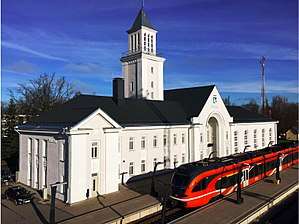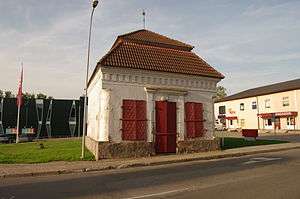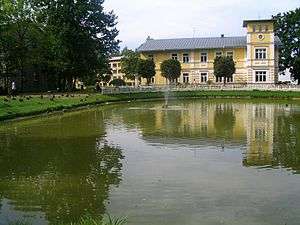Valga
Valga is a town in southern Estonia, on the border with Latvia. Valga and Valka in Latvia are actually one town. Valga is bigger with around 15,000 inhabitants.
Understand

The city has the only railway station through which one can get from Estonia to Latvia. The city is rather dull, but curious about its position on the invisible state border. It has a military museum with a rich exposition dedicated to the Estonian War of Independence.
The border (in the literal sense of the word) location is, perhaps, the most interesting feature of Valga. In the city there are neither medieval monuments nor interesting wooden buildings, so Valga is deprived of the charm and comfort inherent in other Estonian cities. The population of Valga is mixed, 35% Russians, and most other people speak Russian, because it was and is the language of interethnic communication between residents of Estonia and Latvia. The city has a light industry (furniture, clothes and footwear, woodworking). Life along the railway station is convenient, but the overall economic situation is rather bleak, and this is evident to the unaided eye: Valga is one of the poorest county-level cities in Estonia.
- 🌍 Tourist Information Centre, Kesk 11, ☎ +372 766 16 99, fax: +372 766 16 99, e-mail: valga@visitestonia.com.
History
Valga was first mentioned in 1286 under the German name Valga (literally walk). In the 14th-16th centuries, it was a small unfortified settlement, which was regularly destroyed due to numerous wars between the Livonian Order, Russian princes, Lithuanians and Poles. Finally, in 1584 the Polish King Stefan Batory gave Valga the rights of the city. However, the status of a city and the joy of receiving it were short-lived, since already in 1626 Valga belonged to Sweden. Then, after the Northern War, to Russia, which did not acknowledge the city status of the Polish king. Only in 1764, the city status was returned to Valga, after which it started the stone construction. By the beginning of World War I, Valga became a central junction with routes to Riga, Tartu, Pärnu, and Pechora. In 1919, in the vicinity of Valga, the battle for Paju Manor took place - one of the important battles of the War of Independence - after which the Estonian army seized the whole of Southern Estonia and began its offensive into Latvia.
Since its inception, Valga has been multinational in nature: Estonians and Latvians lived here, together with Germans and Russians. Estonians and Latvians did get along very well, because both of them experienced harassment from the Germans. With independence, the situation changed, as both Estonia and Latvia declared their territorial rights of the city. In 1920, after lengthy negotiations with the participation of England, the border was put directly through the city, along the small creek Konnaoja, flowing through the centre of Valga. The big northern part was moved to Estonia, and the smaller southern part to Latvia. The division turned out to be disproportionate, as Estonia demanded compensation for the participation of its army in combat operations in Latvia, and especially for the defeat of the rebellious army of General Bermont-Avalov, who attempted to capture Riga in 1919.
Unlike the by the river divided Narva and Ivangorod, Valga and Valka are a rare example of cities created entirely artificially. During Soviet times the border did essentially not exist. But after the disintegration of the USSR the situation became problematic again due to Latvian burial places appearing in the territory of Estonia. However, after the ratification of the Baltic countries to the Schengen agreement, only striped columns remained from the border, and the transition from one country to another began to occur completely unnoticed.
Get in
- 🌍 Railway station and bus station (about 1 km southeast of the centre). 06–20:00. Built in 1949, the building has a ripped rectangular tower, which is of architectural interest and the most distinct in Estonia. The inside is reconstructed and accessible with shops, toilets, and a ticket desk (M-F 09:00–18:00, break 13:00–14:00).
Bus and train schedules are easily available online – read more under Estonia#Get around.
By train
By bus
- There several buses a day from/to Tallinn (4 hr).
- Almost hourly (6-8 per day) from/to Tartu (1½-2 hr) and Viljandi (1½ hr).
- In addition, direct buses from/to Narva, Pärnu, and even Kuressaare exist. However, it might be easier and faster to transfer half way, going there – see Peatus.ee for connecting journeys.
- Buses from/into Latvia go via the Valka bus station, except for the Riga-Saint Petersburg route, which used the Valga station.
By car
- From Tartu (85 km) highway #3, from Viljandi (80 km) and Pärnu (141 km) highway #6 lead into Valga. From Tallinn it is 235 km (via Viljandi).
- Take the Latvian A3 from Riga (160 km).
By foot
From Valka you can simply walk across the border.
Get around
By foot
Most of Valga's attractions are in walking distance. The border is one bloack west of the town hall.
By bus
The town is served by 2 bus routes, connecting the centre of Valga with its outskirts – frequency 1½ hr, price €0.60 at a kiosk, €1 from the bus driver.
No buses go into Valka.
By bicycle
New bicycle tracks were built in 2009.
See


- 🌍 St. John's Church (Valga Jaani kirik), Kesk väljak (in front of the tourist information centre). An oval-shaped church dating from 1816. It took 30 years to build from 1787. The building exhibits the features of classicism as well as baroque. Also, the oval shape of the church is unusual, as is the location of the bell tower, which is not at the end, but on the side of the building. From the distance, the church might easily be mistaken for a concert hall or a theatre. On the northern wall of the church, there is a memorial plate in memory of the Finnish who volunteered in the battle for the Paju Manor. Guides proudly point out that there is no comparable church in Estonia, which is true.
- 🌍 Catholic Chapel (Katoliku kabel), Riia 16. This small building next to the parking of the supermarket Rimi was a Catholic chapel and is the oldest building in Valga. Although, there has not been any dome or cross on it for a long time. Also, the shutters on the windows are very much like a village shop. The building is especially remembered for its four-slope roof.
- 🌍 Orthodox Church (Õigeusu kirik / Issidori Peakirik), Pargi 2. Equally beautiful as St. John's Church, featuring towers of a similar shape as the Saint Basil's Cathedral at the Red Square in Moscow. It was built between 1897-98. From an architectural point of view, it is decidedly uninteresting, although the interior is pretty and quite spacious. The church has two altars consecrated in honour of the Mother of God and Isidore of Yuryevsky, a priest from St. George's (Tartu), who was killed for refusing to convert to Catholicism.
- 🌍 The Church of the Holy Spirit (Pühavaimu kirik), Maleva 8. A beautiful neo-Gothic church from 1907, built of large stones with layers of brick. This technique was common to the entire Baltic region, but generally not for churches. It was built by the local Catholics, including Poles and Lithuanians that worked on the railway. Rumour has it that the church does not have a bell tower due to a ban of the tsarist government back then.
- 🌍 Old Town Hall, Kesk 11. Built in 1865, the Town Hall is the oldest wooden building in Valga. It is interesting, but not very beautiful. It is an example of early Estonian architecture – from a period when no one thought of national style.
- 🌍 Library and pond (Keskraamatukogu), Aia 12. The building of the library was constructed in 1902 as a manor house. Therefore it also includes a park and a small pond. The style of the building is difficult to determine: it is quite an original.
- 🌍 Valga museum, Vabaduse 8, ☎ +372 7668863. W-F 11:99–18:00, Sa Su 10:00–15:00. An ordinary local history museum, starting with archaeology and ending with the proclamation of independence. The exhibition of Valga's life at the beginning of the 20th century is interesting – Valga is proud of the fact that here was the first mayor of a city which was Estonian, and not German. In addition, there is an exhibition devoted to the railway. €2.
- 🌍 German cemetery and memorial (at the end of Roheline street). From 1941 to 1944 there was a German concentration camp (Stalag 351) on the northern outskirts, which, after the liberation of Estonia, became a camp for German war prisoners. In the late 1940s the Soviet NKVD began using it for punishment purposes. A sad place, located, as it often happens in the Baltic states, in the middle of the purest pine forest. There is a laconic Soviet memorial with the figure of a weeping woman and the inscription "People, be vigilant!" (in Estonian and Russian). And one hundred meters further, a beautiful German cemetery.
- 🌍 Train Monument.
- The urban development of Valga is mostly mediocre. Unusual are the ceremonial stone buildings, built on the central streets in the early 20th century, during the bloom of the city. Take notice of the 🌍 neoclassical building of the new town hall (Kesk 12) from 1912 – also the present board of the county of Valgamaa – the 🌍 building of the museum of local lore (Vabaduse 6-8) from 1911 with the sparse signs of Art Nouveau, and the much more charming 🌍 building of gymnasium (Vabaduse 13) – also in Art Nouveau style. The probably most interesting construction of the Valga is hidden in Kuperjanovi street, an 🌍 abandoned mansion (Kuperjanovi 12) and reference example of Riga modern style, accidentally found in this remote Estonian province. With the exception of a few houses around the old town hall, the wooden architecture of Valga is uninteresting, and actually the five-story concrete building blocks are more numerous than wooden houses here. In the eastern part of the city you can find a rather interesting building, the 🌍 Pentecostal Church (Kungla 34) in Art Deco style and, close-by, several pre-revolutionary factory buildings (Maleva 5).
Also, check out close-by sights of South Estonia#See like Paju Manor (7 km) and Hummuli Manor (15 km) that allow for a day trip from Valga.
Do
- 🌍 Pedele river recreation zone. In summer you can even have a nice swim in the Pedele river.
- 🌍 Beercan Boards, Vabaduse 32, ☎ +372 5520649. M-Sa 10:00-17:00. Rent a long board and explore the town, and even the Latvian Valka. €5 per day.
- 🌍
Military Theme Park (Museum of Patriotic Education / Valga Militaarteemapark-Muuseum / Valga Isamaalise Kasvatuse Püsiekspositsioon SA), Pikk 16, ☎ +372 7671127, e-mail: valga@isamaalinemuuseum.ee. Tu-Su 09:00-17:00. They offer a museum, live-action, but also a guest house and regular restaurant. Check out the website (not in English), in case you are up for such things.
The military museum has two foundations – military and patriotism. The military is represented by a collection of weapons and uniforms, and the patriotism by the work of Estonian fire-fighters and the police on the example of the "Bronze Night" events in Tallinn. Somewhere between these two extremes is an extensive exhibition dedicated to the Estonian army of the times of the first republic and especially to the war for independence. There is a lot of information on outfits, insignia, biographies of heroes – immortalized in the names of Estonian streets – and numerous photographs. The texts are only in Estonian, so history lovers will have to pre-book an excursion in Russian, English or German (€9.60). However, it is even interesting without an excursion, at least from ethnographic considerations, since the museum is created on pure enthusiasm, which is the curious thing about it already. Also there are monuments of modern history: a wooden cannon, created by Estonian volunteers in 1989 due to lack of a normal weapons (looks like a 17th century object); a hut, which was used by Estonian border guards in the early years of independence; a T-34 tank installed in Soviet times in the bloom of Valga and exploded in 1990 by Estonian nationalists. The hut and the tank are part of the outdoor exposition, which can be partially seen from behind the fence, without going to the museum. Finally, have a look in the museum/souvenir store, where helmets, jars and other war items are sold. Museum €5, Accommodation €10, etc..
Eat
Budget
- 🌍 Mammi köök, Vabaduse 2/4, ☎ +372 7679544, e-mail: kaasikuari@hot.ee. M–F 10:00–15:00. Home-style restaurant with cheap prices, but typical local. This is how people live here. "Head isu!" Full meal €3.50, side snakes from €0.50.
- 🌍 Korean bar Horan, Kesk 16 (right next to St. John's Church), ☎ +372 7641655. Su-Th 12:00–21:00, F Sa 12:00–22:00. In case you are looking for something different. But they also feature Latvian dishes. €3–5.
- 🌍 Hesburger, Riia 18, e-mail: valga@hesburger.fi. Daily 09:00–22:00. Finnish fast food chain.
- 🌍 Riia kohvik, Riia 14, ☎ +372 7663874, e-mail: kaie.piiripagar@gmail.com. M–Sa 09:00–18:00. A simple but nice cafeteria on Latvian border. They have more than a dozen types of pizza, as many pancakes, and slightly less hot dishes. Also, a large selection of cakes is available. Pizza €3-5, pancakes € 2, hot dishes €3.
Mid-range
- 🌍 Restoran Lilli, J. Kuperjanovi 6, ☎ +372 7663509, e-mail: restoran@lilli.ee. Su–Th 12:09–19:00, F Sa 12:00–21:00. By all accounts it is a restaurant, the only one in the city. However, the opening hours are more like a café or even a cafeteria. Pasta €4.50, hot dishes €6-9 (2013).
- 🌍 Conspirator Baar, Vabaduse 29, ☎ +372 7679715. Su–Th 12:00–22:00, F Sa 12:00–24:00. More like a restaurant, not a bar. No special alcoholic drinks or cocktails can be expected here, but the list of hot dishes occupies two pages in small print. Cozy and inexpensive. Hot dishes: €5-7.
- 🌍 Voorimehi Pubi, Kuperjanovi 57, ☎ +372 7679627. Su-Tu 12–24:00, W 12:00–2:00, Th 12:00–24:00, F Sa 12:00–03:00. The choice of hot dishes leaves much to be desired, but late in the evening this pub becomes one of the few places where you can eat. Discotheque on the weekends. FB. Main courses: €6-8 (2014).
Splurge
- Metsis, Kuperjanovi 63 (see hotel below), ☎ +372 7666050, +372 56230110. M-F 11:00–23:00, Sa 12:00–23:00. The restaurant at the hotel of the same name, decorated for a hunting castle, hides and reindeer horns are hung on the walls. The food is cooked in French style, so here is the only opportunity in Valga to eat elegantly. Main courses €9–13 (2014).
Drink
- 🌍 Exotica, Turu 6, ☎ +372 5533369. F Sa 11:00–04:00. Night club.
- 🌍 Yes!, Tolli 1, ☎ +372 5235515. F Sa 22–04:00. The nightclub adjoins the Tolli Hostel.
Sleep
The Military Theme Park offers cheap accommodation in case you come with a group of friends and are up for a different experience.
Budget
- 🌍 Helge Guest House, ☎ +372 55599994. A friendly place with 4 beautifully furnished guest rooms. Also features a sauna for colder days – ask ahead if it's available. From €16 single.
- 🌍 Maria Hostel, Mesipuu 1, ☎ +372 5042392, e-mail: info@mariahostel.ee. Check-in: 14:00, check-out: 12:00. Hostel with rooms for 1-4 people. Shared bathroom and toilet. Nevertheless, the hostel is rarely filled, so not that bad. There is a kitchen. They also prepare breakfast for €3. The front door is usually closed, so call ahead. €15/€20/25/45/60 dorm/single/double/triple/quad.
- 🌍 Külalistemaja Säde, Jaama pst 1, ☎ +372 7641650. Double €40.
Mid-range
- 🌍 Hotel Metsis, Kuperjaanovi 63, ☎ +372 7666050, e-mail: info@hotellmetsis.com. €55/68 single/double.
Go next
- Karula National Park – The hilly landscapes of Southern Estonia. Estonian’s smallest national park on the way to/from Võru.
- Võru – A picturesque town not far from the highest hill in the Baltic states, Suur Munamägi. The birthplace of the writer Kreutzwald and the dialect of the Estonian language.
- Sangaste and the nearby Sangaste Castle, just 30 km north.
- Otepää – A small town set in the hills of south Estonia and best known winter sports centre in the Baltics, and the Winter Capital of Estonia. Surrounded by lakes, hills and ski jump towers.
- Tartu – 85 km northeast from Valga. Museum-rich and hanseatic city on the banks of the Emajõgi River. Also, Estonia's second-largest and oldest city, intellectual hub famous for its universities, and a lively student city.
- Viljandi – A beautiful, ancient and hilly city, known for its annual Viljandi Folk Music Festival, beautiful old town and overwhelming and picturesque park around the old castle.
- Tõrva – The second largest city of Valga County after Valga. Popular for its caves, the ruins of a medieval castle, several interesting manors, and the fully authentic mausoleum of Barclay de Tolly.
- Valga is the gateway to Latvia with its beautiful capital Riga, the Baltic sea resorts Jūrmala and Ventspils, as well as the Vidzeme region next to Valga with the picturesque Sigulda (Latvian Switzerland) and Cēsis, and Valmiera with the only professional theatre in this region of Latvia, castle ruins, a medieval church, a famous brewery and the start of the Gauja National Park. Valmiera and Cēsis even allow for day trips from Valga.